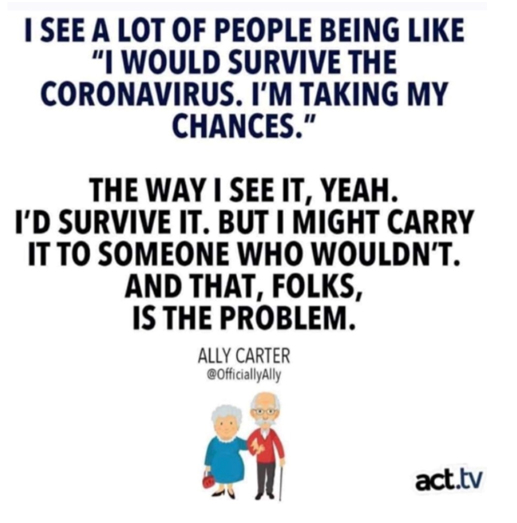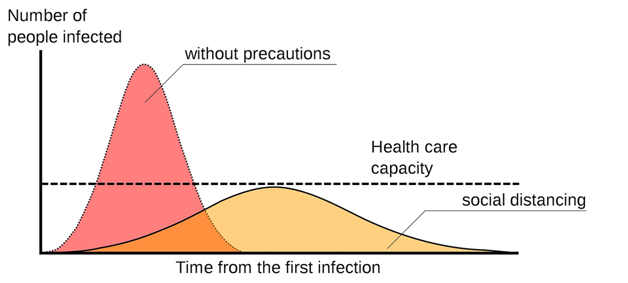By now the coronavirus has spread globally and everyone is (if they aren’t they should be) talking about being socially responsible by taking part in #socialdistancing to #flattenthecurve.
Until last week I didn’t personally know anyone that has the coronavirus (now I know two people in Bangkok), but I was already practicing social responsibility for several reasons. If I become infected it is likely that I would recover well as I am young and don’t have any pre-existing conditions; but both my parents are over 60 (one is diabetic), my grandmother is almost 90, and my siblings are both immunocompromized which makes them ALL part of the high risk population. If any of them become infected it would be harder to recover and they would definitely need access to medical care.
Someone posted this image on social media and it really resonated with me:

Dr. Alok Patel from UC San Francisco explains social distancingby saying that it is essentially everyone doing their best to stay away from large crowds while we’re trying to reduce the spread of this disease. Imagine a crowded room full of people. Everyone in the room is healthy except 1 person who is affected with the coronavirus but they don’t know it. They shake hands with half the people in the room, and let’s say half of those people get infected. Over the next 5 days those people go on with their lives. Some develop what seems like a cold, others have no idea they’re sick but they’re spreading the coronavirus along the way infecting friends, family, and strangers without even knowing. That’s what health experts call an outbreak. Social distancing keeps the number of people in that crowded room from ever being infected by not being crowded. Dr. Patel says, “Social distancing is everybody’s responsibility. It’s the role to play in protecting your community and slowing the spread of the coronavirus.”
Here’s a video of Dr. Patel explaining the narrative above.
There’s also a lot of talk now about how #socialdistancing will #flattenthecurve, but firstly, what is the curve?
The “curve” researchers are talking about refers to the projected number of people who will contract COVID-19 over a period of time. (To be clear, this is not a hard prediction of how many people will definitely be infected, but a theoretical number that’s used to model the virus’ spread.) Here’s what one looks like:

The curve takes on different shapes, depending on the virus’s infection rate. It could be a steep curve, in which the virus spreads exponentially (that is, case counts keep doubling at a consistent rate), and the total number of cases skyrockets to its peak within a few weeks. Infection curves with a steep rise also have a steep fall; after the virus infects pretty much everyone who can be infected, case numbers begin to drop exponentially, too.
The faster the infection curve rises, the quicker the local health care system gets overloaded beyond its capacity to treat people. As we’re seeing in Italy (which we’re trying to prevent the rest of the world from experiencing), more and more new patients may be forced to go without ICU beds, and more and more hospitals may run out of the basic supplies they need to respond to the outbreak.
A flatter curve, on the other hand, assumes the same number of people ultimately get infected, but over a longer period of time. A slower infection rate means a less stressed health care system, fewer hospital visits on any given day and fewer sick people being turned away.
For a simple metaphor, consider an office bathroom.
“Your workplace bathroom has only so many stalls,” Charles Bergquist, director of the public radio science show “Science Friday” tweeted. “If everyone decides to go at the same time, there are problems. If the same number of people need go to the restroom but spread over several hours, it’s all ok.”
How do we flatten the curve?
As there is currently no vaccine or specific medication to treat COVID-19, and because testing is so limited in the U.S., the only way to flatten the curve is through collective action. (compiled from Live Science).
I listened to a live webinar organized by the Global Healthcare Resources and led by Dr. Marc Lipsitch, a Harvard Epidemiologist, says social distancing is crucial. The means by which to do that are to cancel public gatherings, close houses of worship, restaurants etc. He essentially says that if it were up to him he would close everything including schools and mass transit. He does make a point that there’s nothing bad about being outside the house. The problem is density of people and poor ventilation so it’s not that you can’t leave the house for 6 months, but if you are high risk you should have someone else go pick up your medication and food for you if you can. Vaccines are going to take at least a year, and could be considerably longer. Treatments are easier to test because they already exist. They are antiviral drugs that were designed for another purpose.
Dr. Lipsitch hit the nail on the head when he said, “Social distancing is a societal phenomenon. It takes all of us doing it that will make it work. It’s a lot like vaccinations, you do it for yourself and for other people. It’s a social responsibility to try and slow down the transmission as a member of society.”
Take care of yourselves, your loved ones and the global community by choosing to practicing social distancing.
Information compiled by Devi Bajaj
Founder and Director of Enliven Health Concierge
Below are links to more details related to the information above:
- https://www.flattenthecurve.com/
- https://www.washingtonpost.com/graphics/2020/world/corona-simulator/
- https://www.nytimes.com/2020/03/11/science/coronavirus-curve-mitigation-infection.html
- https://www.npr.org/sections/health-shots/2020/03/13/815502262/flattening-a-pandemics-curve-why-staying-home-now-can-save-lives
- https://www.npr.org/sections/health-shots/2020/03/17/817214311/new-analysis-suggests-months-of-social-distancing-may-be-needed-to-stop-virus
#EnlivenConcierge#Coronavirus#Covid19#SocialDistancing#SocialResponsibility#StayHome#WorkFromHome#WFH#FlattenTheCurve

